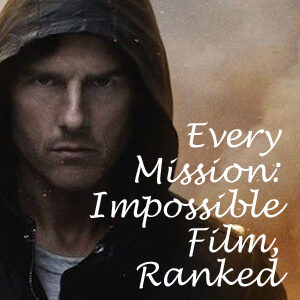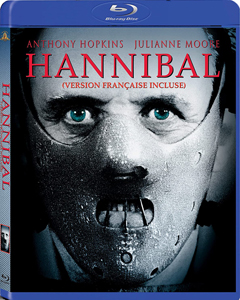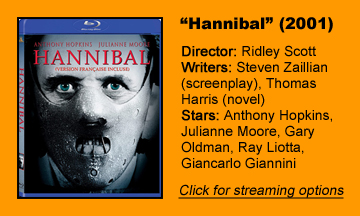To mark the 40th anniversary of author Thomas Harris’ invention of Hannibal Lecter and the 30th anniversary of “The Silence of the Lambs” – the only horror film to win Best Picture – we’re looking back at the four books and five films of the Hannibal Lecter series over nine Frightening Fridays. Next up is the third film, “Hannibal” (2001):
Chemistry lost
It must be frustrating to be a writer or director and get praised when actors have chemistry and criticized when they don’t; so much of the pairing is inexplicable magic. Jody Foster and Anthony Hopkins have it in “The Silence of the Lambs” (1991), but Julianne Moore and Hopkins don’t in “Hannibal.”
Writer Steven Zaillian and director Ridley Scott obviously know what they’re doing, and none of their choices strike me as glaringly wrong as they adapt Harris’ thickest novel; for the third straight film, it’s a quite faithful adaptation.
It’s the first that puts Hannibal (Hopkins) in the spotlight, but Starling (Moore) is still front and center, too. Meanwhile, the film slowly builds toward something that has previously, surprisingly, been in the background: the fact that Hannibal eats people. Three films in, he finally brings out his kitchen finery.
Toned-down shock value
This adaptation is not hard to watch – it’s a sweeping, professional production; plus, it’s another example of shock value for non-horror fans. Sure, there are pigs eating people, and in the memorable finale, Lecter feeds smarmy FBI agent Krendler (Ray Liotta) a piece of his own brain.
I’ve heard some viewers describe that scene as “dumb,” some as puke-worthy. But I was like “Hmm, that’s something you don’t see every day,” and then I moved on.
What’s shocking in the book comes off more rote in Scott’s film. I don’t feel much concern that the boars might eat Hannibal’s feet in that barn sequence.
The best horror element is simply Mason Verger himself, the deformed man who wants revenge on Hannibal. I’ll have to take the credits’ word that it’s Gary Oldman under the makeup and prosthetics, but he’s great as always as he brings to life this latest instant-classic Harris villain.
Still – while his plan to feed Hannibal to ravenous pigs is creative — Verger doesn’t come off as a huge threat; his grisly demise is entertaining, but it might’ve been better if he was nastier to his underlings than what we see, or if his twisted relationship with his sister came into play.
Margot Verger isn’t in the film at all. After watching the TV series “Hannibal,” it’s even clearer where the film “Hannibal” fails to tap into the skin-crawling mutilation, cannibalism and general sociopathic violence.
Artfully distant
The movie “Hannibal” maintains its distance, but it does so in an artistic way, with a Hans Zimmer score featuring a notable amount of bass (though not as much as his Batman work), and images from Florence, Italy.

The middle act wherein Hannibal outsmarts Italian investigator Pazzi (a solid Giancarlo Giannini) is the high point. The inevitability of the outcome pairs well with the divine tragedy of the obsessed Pazzi, for whom a beautiful wife and a decent life of opera-going are not enough.
But that’s an interlude rather than something intimate. “Manhunter” and “Silence” are very personal, not only because they focus on Will and Clarice, but also because the two agents have people in their circles, from Will’s wife to Clarice’s supportive boss and roommate – and, honestly, Hannibal.
In this entry, Clarice’s boss, Jack (Scott Glenn in the previous film), is completely absent as Clarice thrown under the bus by Krendler. Clarice being on a one-woman island might actually be a good storytelling element, because it could lead to a tighter Lecter-Starling bond. I think we would’ve gotten that if Foster had returned.
I like Moore as an actress; she’s fine in any given scene, and her vintage beauty fits with the overall aesthetic in the same way Hannibal’s refinement does. But Moore doesn’t commit to the West Virginia accent, and even though the actress nicely moves Starling into the era of a seasoned, back-talking agent, deep down I don’t accept her as the same character Foster played.
A different conclusion
Zaillian (who wrote this film himself despite the official co-credit with David Mamet, who had nothing to do with the final screenplay) drops the controversial conclusion of the novel, wherein Clarice and Hannibal are romantically linked. Maybe it was an in-production adjustment to how Moore and Hopkins read on screen. But it’s not replaced with anything better.
Whether you love, hate or slightly raise your eyebrows at the brain-eating dinner sequence, what happens after that is bungled. Hannibal seemingly cuts off Clarice’s hand to escape his handcuffs, but then we see he didn’t really. He’s gone, but it’s unclear if she let him go.
Then Zaillian repurposes a scene from earlier in Harris’ book for a kicker: Hannibal feeds a piece of brain to a kid on a plane.
“Hannibal” doesn’t miss the mark by a lot, but I was consistently aware that it doesn’t click in the way of “Silence” or TV’s “Hannibal.” On the other hand, I appreciate that it’s faithful to Harris’ work – except for the very end – and we also get another classic Oldman performance to add to our collection.
And the two leads aren’t bad, they just have the bad luck of not pairing well, like a wine that’s wrong for the meat.


